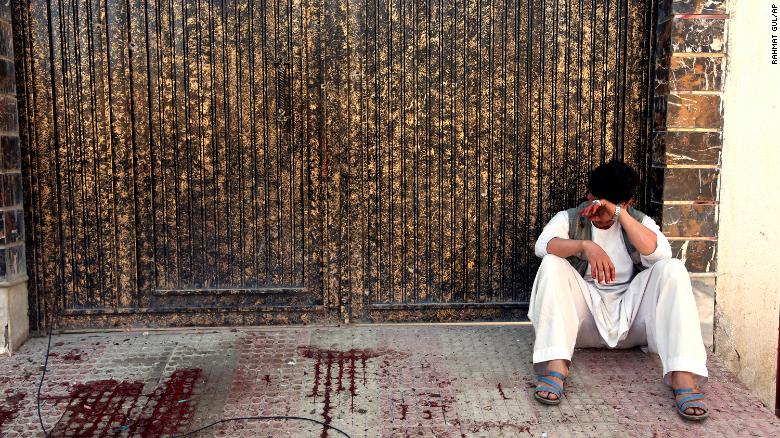The second explosion came as the attacker detonated explosives as journalists huddled around the scene, Kabul City Police spokesman Hashmat Stanikzai told CNN.
In a statement issued via the social-media app Telegram, ISIS said a “martyrdom brother” blew his explosive vest up among a group of “apostates” and killed and wounded a number of them. The group named the first bomber as Qaqaa al-Kurdi and the second attacker as Khalil al-Qurshi. ISIS did not provide any evidence for the claim.
Eight journalists, including at least one woman, died in the blasts, according to Sharifi.
In a tweet Monday, AFP’s Global News Director Michele Leridon honored Marai for his “extraordinary strength, courage and generosity” and praised his “consummate professionalism” and “sensitivity” during his 15 years covering the Afghan conflict for the news agency.
AFP said the death of its “treasured colleague” was “a devastating blow”.
Leridon sent “condolences to the families of other journalists killed in this terrible attack”.
A further 45 people were injured in the two incidents, and have been taken to city hospitals, according to Ministry of Public Health spokesman Wahid Majroh.
The agency said Marai joined AFP as a driver in 1996, the year the Taliban seized power, and in 2002 he became a full-time photo stringer, rising through the ranks to become chief photographer in the bureau.
AFP’s Leridon said in a statement, “This is a devastating blow, for the brave staff of our close-knit Kabul bureau and the entire agency. Shah Marai was a treasured colleague who spent more than 15 years documenting the tragic conflict in Afghanistan for AFP.”

This undated file photo released by AFP on April 30, 2018 shows AFP photographer Shah Marai in Kabul.
Agence France-Presse’s chief photographer in Kabul, Shah Marai, was killed April 30, AFP has confirmed, in a secondary explosion targeting a group of journalists who had rushed to the scene of a suicide blast in the Afghan capital. / AFP PHOTO /
He leaves behind two wives and six children, including a newborn daughter, AFP said.
In an essay entitled “
When Hope is Gone,” written in 2016 — before the birth of his sixth child — he acknowledged the danger of living in the city with his young family.
“I don’t dare to take my children for a walk. I have five and they spend their time cooped up inside the house.
“Every morning as I go to the office and every evening when I return home, all I think of are cars that can be booby-trapped, or of suicide bombers coming out of a crowd. I can’t take the risk.”
The site of the explosions was close to NATO’s Afghan headquarters, the US embassy and Afghan government buildings, including the Presidential palace, the Defense Ministry and the headquarters of Afghanistan’s intelligence services.
US Ambassador John Bass responded to the attack by restating the US resolve to combat terrorists in Afghanistan.
“I condemn today’s terrible Kabul attack (and) reaffirm our commitment (to) stand with the Afghan people in their fight for peace (and) security across Afghanistan. We mourn for those murdered, including the brave journalists who stand for truth in the face of violence,” he wrote on Twitter.
Spate of attacks
A few hours after the strikes in Kabul, an attack in Kandahar Province killed 11 students at a local religious school. The suicide bomber had targeted a convoy of Romanian soldiers. Five of them were injured in the blast.
No group has yet claimed responsibility.
Afghanistan has witnessed a spate of attacks in recent weeks. Days ago at least
six people were killed, including two Afghan soldiers, when a car bomb exploded in Afghanistan’s southern Helmand province.
On April 22, a suicide blast
killed 57 people — including at least five children — and wounded over 100 more at a voter registration center. That attack was preceded by
a car bombing in southern Afghanistan in which at least 13 people were killed and 35 others injured.

A relative of a victim cries outside a voter registration center which was attacked by a suicide bomber in Kabul, Afghanistan, Sunday, April 22, 2018. Gen. Daud Amin, the Kabul police chief, said the suicide bomber targeted civilians who had gathered to receive national identification cards. (AP Photo/ Rahmat Gul)
he incident took place outside a sports stadium in Lashkar Gah, the capital of Helmand province. A wrestling match was taking place inside the stadium at the time of the attack.
The uptick in violence comes despite
reports around six weeks ago that suggested some factions of the Taliban had expressed interested in pursuing peace talks with the Afghan government.
Those reports came on the heels of an Afghan government announcement in February that it would be willing to recognize the Taliban as a legitimate political party as part of a potential ceasefire agreement with the Islamist militant group.
from : CNN Updated 1636 GMT (0036 HKT) April 30, 2018
link : https://edition.cnn.com/2018/04/30/asia/afghanistan-kabul-blasts-intl/index.html
![]()










